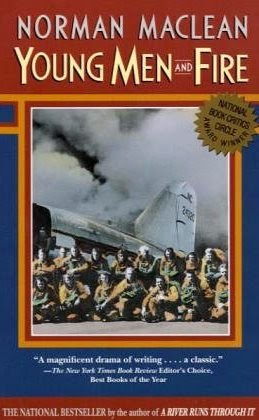Many, many moons ago, I finished reading Young Men and Fire. I'm not sure why I have been unwilling to write about it. Maybe it's because I'm not sure I can say I enjoyed it. I found it gripping, except for a bit I'll talk about later.
Nevertheless, I was transfixed by it. It was fascinating, one of those stories where you know at the beginning how it's going to end, but the wonder is in what you learn along the way.
I bought this book a few years back, after listening to an episode of The Story about this and other forest fires. I did a bit of searching around on this internet after that, and found several videos set to the Cry Cry Cry version of "Cold Missouri Waters" (here is one version; though it was written by James Keelaghan, I like Cry Cry Cry's better) which tells the story of the Mann Gulch fire from the point of view of the jump crew chief, Wag Dodge.
On the day of the fire in August 1949, the Montana mountains had been baked by an unusually hot and dry summer. Lightning started a fire in Mann Gulch, and Wag Dodge and his crew of jumpers were sent to get it under control. Smoke jumping was still in its infancy, and still learning the lessons which were taught by World War II. It was an imperfect and inexact science.
A collection of unfortunate circumstances, a "perfect storm," to borrow the title of a later book about an environmental catastrophe, combined to make the fire one of the deadliest in US Forest Service history. Only two of the jumpers survived, plus Dodge (though he died a few years later). The longest-lived survivor, Robert Sallee, died just over a year ago at the age of 82.
It's curious that the part of the book I found the least interesting -- the section near the end where the author gets into more
advanced and recent (1980s) development of the study of wildfires,
specifically related to simulations and the study of how fires spread in the mountains -- is probably the greatest legacy of the Mann Gulch. Regardless, I found that section tedious. The studies happen in labs; I wanted to get back out on that steep, rocky hillside and hear more stories.
If you want to read more about the fire, there are a couple of websites devoted to it. This one has a nice step-by-step summary of the fire, if you're not ready to dive into the full book.
"If a storyteller thinks enough of storytelling to regard it as a
calling, unlike a historian he cannot turn from the suffering of his
characters. A storyteller, unlike a historian, must follow compassion
wherever it leads him. He must be able to accompany his characters,
even into smoke and fire, and bear witness to what they thought and felt
even when they themselves no longer knew. This story of the Mann Gulch
fire will not end until it feels able to walk the final distance to the
crosses with those who for the time being are blotted out by smoke.
They were young and did not leave much behind them and need someone to
remember them."

No comments:
Post a Comment